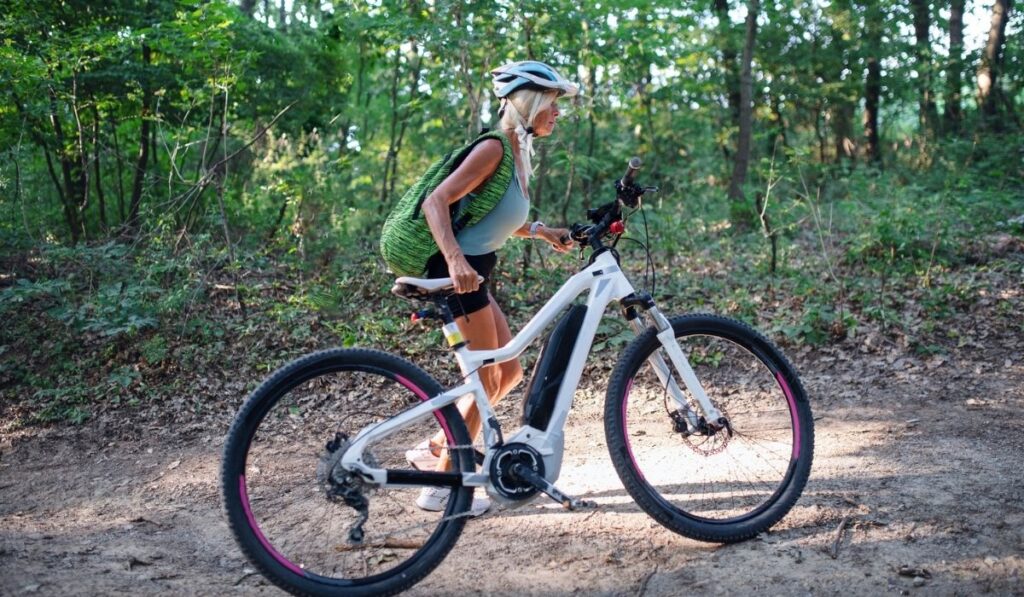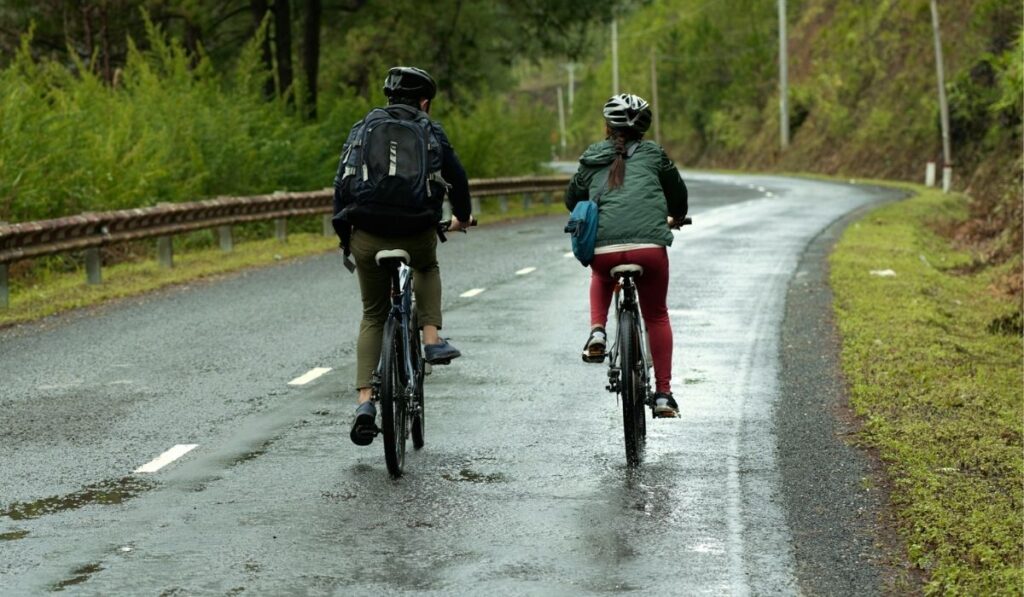Whether you’re using your bike for commuting or just the occasional ride in the neighborhood, rain can hit you when you least expect it. So, how well do manufacturers waterproof their products? And what do waterproofing and water resistance even mean?
E-Bike motors are designed to work in the rain, but shouldn’t be submerged for long periods of time. Manufacturers typically use “waterproof” and “water-resistant” interchangeably, and one isn’t better than the other. If you ride in the rain a lot, consider extra waterproofing.
If you’re shopping for an e-bike, you probably want to get the best bike you can without breaking the bank. While expensive models have decent water protection, what about budget bikes? Today, we’ll get to the bottom of whether or not you need to worry about a little rain. Read on to learn more!
What Types of E-Bike Motors are There?

While you might imagine e-bike motors to be generally all the same, that’s not quite the truth. Motors need to perform a particular task, and that’s making the wheel move.
But they can accomplish that in a few different ways.
In most cases, all e-bike motors will be a type of motor called a BLDC motor. But after that, there are a few different styles of motor that build on that technology.
Popular types of e-bike motors:
- Mid-drive — Mid-drive motors sit near the middle of the bike on the bike’s crank. An electric motor generates torque that disperses through the bike’s chainring.
- Direct-drive — These sit on the hub of the e-bike. Essentially, the motor’s shaft becomes the axle of the rear or front wheel.
- Gear-hub — Similar to direct-drive, gear-hub motors utilize planetary gears to generate more torque but less top-end speed.
While each type of motor utilizes different methods to generate power, in most cases, their components will be housed and protected from water, dirt and other contaminants. Manufacturers build these motors to stand up to the environment that a bike might come in contact with, namely water.
This is true for a lot of different e-bikes, but be wary of cheaper models. While they may last for a while, the lower quality components might mean that the water-proofing process is less than reliable.
Additionally, DIY style kits, like this one (on Amazon), may not provide the same kind of waterproofing quality either.
Water Resistance Ratings – How Wet is Too Wet
When it comes to keeping moisture out of electronics, there is a system in place to grade how well a device can keep the water out. Unfortunately, common industry terms like “water-proof” don’t carry the same type of reputation.
So, what should you be on the lookout for when shopping for an e-bike?
When it comes to water resistance for electronics, you should be on the lookout for an IP rating. This rating indicates the level of dust and moisture protection that a particular device has. You’ll usually find two numbers that represent the specific levels of dust and moisture that a device can stand up against.
The first number estimates intrusion protection from dirt and dust. It ranges from 0 to 6, with 6 offering the most protection and also being termed “dust tight.” The second number indicates moisture protection.
Again, the second number ranges in protection levels from 0 to 9, with 9 offering protection against high-pressure water jets. It’s worth noting that a lower IP rating will suffice for our purposes.
While it’s fairly common to see an IP rating on electronic components like a motor, this information might be hidden away somewhere in the user’s manual. Additionally, you may see terms like water-proof or water-resistant on the packaging or other marketing materials.
As these terms don’t really have a universal definition or industry standard, they basically don’t mean much in terms of protection.
Waterproof vs. Water-Resistant – What’s The Difference?
These are, by and large, the two most common terms you’ll see plastered on e-bike packaging. Moreover, it’s fairly common to see on other consumer electronics as well.
What, if any, is the difference between the two terms?
Again, these two terms don’t really have a universal standard definition. For some companies, they may be the same. For others, it could mean one is better suited for environments where the device will be fully submerged rather than in a moist environment.
In most cases, water-resistant will offer more protection. However, if you’re truly looking for protection, you’ll want to search out the IP rating of a product. Only this rating has a verifiable standard that is used by professionals.
Can I Leave My E-Bike Out In The Rain?
In a perfect world, we’d all have the opportunity to bring our e-bikes in during rain or otherwise bad weather. You’d also never ride in the rain. However, that’s not the world we live in.
In fact, if there’s one thing you can’t control, it’s the weather. So you’re bound to get stuck in a squall every once in a while. But what happens if you leave your bike out in the rain?
While your e-bike can certainly stand up to a bit of rain, leaving it out for long periods of time will certainly have an impact. Not only will weather wear down other components of the bike, but even the most water-resistant motors will develop issues over time if left out in undesirable conditions.
You’ll also have to worry about the sunny days. Sun damage can wear down your e-bike much faster than the rain. UV light is very destructive.
Long-term sun exposure can crack paint, make plastic components brittle and wear down your battery much more quickly.
If you can, limit the amount of time your bike spends just sitting outside. We know that this is not an option for everyone. If you’re in an urban setting where space is at a premium, you’ll want to make sure to try your best to park your bike in a covered area if you can.
Additionally, keeping up with proper maintenance can certainly benefit the longevity of components.
How To Waterproof Your E-Bike?

When it comes to waterproofing your e-bike, what are your other options? What can you do to make the most out of your bike’s water protection and keep out moisture that can ruin components? Other than the standard waterproofing that comes with your bike, is there anything else that you can do?
With something like an e-bike that most likely already has waterproofing of some sort, adding extra protection can get tricky. You can use something like extra Waterproofing Boat Tape(on Amazon) to seal off the motor and wiring — but that’s pretty much it.
The best way to prevent water damage is by making sure you don’t put your bike in super wet environments.
For example, riding through large puddles is by and large the best way to get your bike soaked. Avoid them if you can while you’re riding.
Also, if you can, limit your rides outside when it’s raining heavily. Of course, this won’t be as much of an option for people using their e-bike for commuting.
Lastly, try and source the right bike for your riding style. An urban commuter bike won’t be at home on the trails where things can get fairly rough and wet. If you plan on taking your bike in these kinds of conditions, make sure you get something like a Mountain E-Bike (on amazon).
How to Safely Ride Your E-Bike in the Rain?
When it comes to riding your e-bike in the rain, the motor is fairly protected against the elements. But that’s not the only thing you need to worry about.
In fact, while you should be concerned about the protection of the electric components of your bike, you’ll also want to look out for your own safety. Below you’ll find some of our top tips for riding your bike in the rain.
- Use a fender — A fender can protect more than just your battery or motor; it can also help keep splatter from the wheel from soaking your backside!
- Wear the proper attire — If you’re riding in the rain, you’re definitely going to get wet. Wearing rain gear and warm clothing is key.
- Keep your stuff safe — Using a waterproof backpack (on Amazon) or bike saddlebags (see on Amazon) are great ways to keep your gear safe from the elements.
- Use lights — Rain is a visual obstruction for drivers and other cyclists. Keeping safe means remaining visible. Bike lights are always recommended in rainy conditions.
- Safe riding — Keep your speed to a minimum and take things slow. The last thing you want to do is crash in the rain, and it’s very easy to do in the slippery conditions.
Keeping those tips in mind when you ride will help ensure that you get to your destination safely. When it comes to keeping your bike safe, you’ll want to make sure you’re cleaning off components like gears, the motor, chain and the battery.
Wrapping Up
When it comes to e-bikes and the rain, you don’t need to worry too much. Of course, you don’t want to go and submerge your motor in a puddle, but for most conditions, it shouldn’t be much of a worry.
Check your e-bike’s IP rating to find out how water-resistant its electronic components are.
Additionally, you’ll want to make sure you’re keeping up with proper maintenance and not leaving your e-bike outside for long periods of time. Riding in the rain is also more dangerous than riding in perfect conditions, so you’ll want to be as careful as you can on your ride.

zelma
Wednesday 25th of January 2023
Waiting patiently for you to come home and fuck me! https://cutt.ly/R9omJXa